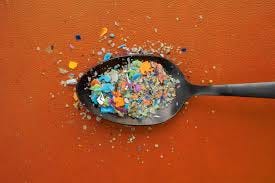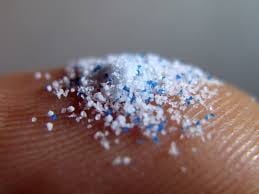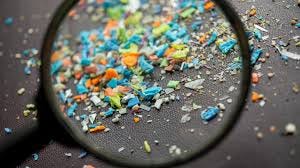The Plastic Inside You: What It’s Doing and How to Fight Back
The hidden contaminants you're consuming in your daily life and how to reduce your exposure
You can’t see them. You can’t taste them. But they’re in your water, your food, your clothes, your lungs—and yes, even your blood.
They’re called microplastics, and they’re silently invading your body, one invisible particle at a time.
Let’s break down what they are, how they got here, and what you can actually do to protect yourself.
What Are Microplastics?
Microplastics are tiny plastic particles — usually smaller than 5mm— that break off from larger plastic items or are manufactured that way (like microbeads in cosmetics). Generally speaking, there are two main types:
Primary microplastics: Intentionally made small (think glitter or microbeads).
Secondary microplastics: Result from the breakdown of larger plastics (like water bottles, tires, or packaging).
Once released, they’re permeate everywhere: into our oceans, rivers, rain, soil, animals… and us.
How Microplastics Took Over the World
The rise of microplastics is a side effect of our love affair with convenience. Over the last 70 years, plastic use has exploded —from food packaging and synthetic clothes to toothbrushes and tires.
But plastic doesn’t biodegrade — it breaks apart.
Add to that the rise of fast fashion, bottled water, and single-use everything, and suddenly, we’re in a world where:
Microplastics fall from the sky in rain.
They're detected in the placentas of unborn babies.
The average person may ingest up to 5 grams of plastic per week — the equivalent of a credit card. 😳
But what are the hidden risks of Microplastics?
The Hidden Risks of Microplastics
Research is still catching up, but early findings raise red flags:
🔥 1. Inflammation & Cellular Stress
When microplastics enter the body — whether through food, water, or air — they don’t just pass through unnoticed. They can irritate tissues and trigger your immune system, much like a splinter or foreign object would.
What happens next?
Your body recognizes the plastic particles as invaders.
This kicks off an immune response: white blood cells swarm, inflammation sets in.
The chronic presence of microplastics can lead to oxidative stress, where your cells produce too many free radicals.
Over time, oxidative stress can damage DNA, proteins, and cell membranes, potentially contributing to aging and diseases like cancer or neurodegeneration.
🧪 2. Endocrine Disruption
Many plastics contain endocrine-disrupting chemicals (EDCs) — like BPA, phthalates, and styrene—that can leach out from the plastic and mimic hormones in your body.
How does that mess with you?
These chemicals can imitate estrogen, testosterone, or thyroid hormones, leading to hormonal imbalances.
In children and teens, this can disrupt growth and development.
In adults, it may impact fertility, mood, metabolism, and even increase the risk of hormone-sensitive cancers like breast or prostate cancer.
Even tiny exposures — especially when repeated over time—can have outsized effects due to the delicate balance of your hormonal system.
🫀 3. Bioaccumulation in Organs
Unlike food or nutrients that are digested and metabolized, plastic particles don’t break down easily in the body. Studies suggest that microplastics can:
Cross the gut barrier and enter the bloodstream
Accumulate in organs such as the liver, spleen, kidneys, and even the brain
Travel via placental tissue—meaning they may reach unborn children during pregnancy
Once embedded in organs, these particles could cause chronic inflammation, interfere with cellular function, and potentially increase the long-term risk of disease. We’re just beginning to understand the implications of having plastic build up in tissues not designed to handle foreign particles.
Microplastics aren’t just a pollution issue — they’re a personal health issue.
Now, how can we reduce our exposure to these harmful particles?
3 Heavy-Hitters in Reducing Your Microplastic Exposure
Now for the good news: You can dramatically lower your exposure with a few high-impact changes. H
ere are the three least effort, highest impact changes you can make:
1️⃣ Filter Your Water 💧
This is an intuitive one. Everyone suspects plastic bottles are tap water aren’t the cleanest form of water.Tap water — and even bottled water — often contains microplastics. Studies show bottled water can contain 2x more particles than tap.
What to do:
Install a high-quality water filter (look for ones certified to remove microplastics, like reverse osmosis systems).
Use stainless steel or glass bottles — ditch single-use plastic.
2️⃣ Rethink Your Laundry 🧺
Looking for a reduction method you haven’t heard before? Synthetic fabrics like polyester, nylon, and acrylic shed plastic fibers with every wash — millions per load. These then “latch on” to your clothes and can drop off elsewhere (in your house, in your food, onto your skin).
What to do:
Use a microfiber-catching device (like a Cora Ball).
Wash clothes less often and on colder, gentler cycles.
Buy natural fibers like organic cotton or wool.
3️⃣ Make the Switch in Food Storage & Prep 🍽
Heating plastic can release micro and nanoplastics directly into your food. It’s that easy and I’m guessing we’ve all suspected this one for awhile too.
What to do:
Avoid microwaving food in plastic containers (it’s not just the first use!).
Store leftovers in glass or stainless steel (alternative materials are cheaper today than ever… give them another look!).
Cut back on plastic-wrapped produce and processed foods (coffee cups, water cups, pre-packaged snacks, canned goods).
FUN FACT: Printed receipts (yes, the kind you could easily be denying at the register, are a leading source of microplastic exposure!
What We Covered
The goal of this post was not to freak anyone out about how they’ve been living their lives, but draw some attention to it. Hopefully this will allow you to be mindful about your own habits related to this topic.
It’s hard to attribute health issues to microplastics, but it is certain that the amounts in our bodies is increasing. A causal relationship may not be able to be established, but if you are looking to squeeze the lemon a bit further — taking some steps that compound over your life is probably worth it.
Key takeaways ⬇️ :
Microplastics are everywhere — and yes, you’re likely consuming them.
They originate from everyday plastics and now contaminate air, water, and food.
The health risks are real, and they are wide-ranging: from inflammation, to hormone disruption, to fertility.
But you can fight back. Making small changes towards a less plastic-centric life counts.
Want more no-BS breakdowns on the science that impacts your daily life? Hit subscribe and never miss a deep dive.
Start with ONE Change This Week
You don’t need to go plastic-free overnight.
In fact, I don’t want you to freak out at all.
Just start with one habit: filter your water, make the switch to glass or stainless, or try a microfiber filter for laundry.
Every small step lowers your exposure — and sends a message to industries that changes may need to be made on their end…
Also, if you’d like more ways to reduce your exposure to Microplastics, interact with this post (restack, comment, DM me) and I will get you a list of 5 more ways to do so!
In Learning,















